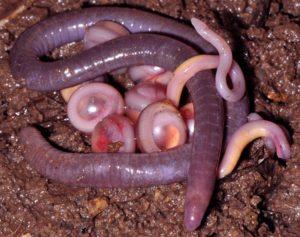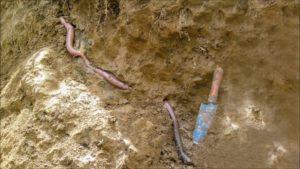How worms breed: are the halves friendly with each other
People living in rural areas often encounter earthworms. The presence of these creatures on the site brings tangible benefits, so gardeners and gardeners do their best to create comfortable conditions for their reproduction.
Content
Features of reproduction of earthworms
The breeding season of earthworms depends entirely on the weather conditions in their habitats. In temperate regions, this occurs from about May to September, but worms that live in a warm tropical climate can breed year-round.
A serious obstacle to reproduction can be the onset of cold weather or a prolonged drought. In such harsh conditions, animals stop looking for food, descend deeper into the soil and fall into suspended animation.
Despite various myths, worms reproduce exclusively sexually. As a result of cross-fertilization of two adults, eggs are born, which are protected by a dense oval cocoon. One such cocoon can contain from 1 to 20 eggs inside.
The structure of the genital organs of an earthworm
Earthworms reach sexual maturity at the age of 3-4 months. In the region of 32-37 segments of the body of the worm, a light seal appears, called a girdle. The appearance of this seal indicates that the worm has matured and is able to produce offspring.
https://youtu.be/7moCDL6LBCs
How does fertilization take place
After an adult earthworm reaches puberty, it finds a partner to give birth to offspring. The whole process of worm reproduction can be divided into several stages:
- Two adults come into contact with their abdomens and exchange sex cells, after which a cocoon is formed inside the girdle, and inside the cocoon eggs ripen from eggs. The egg maturation process takes 2 to 4 days.
- A special pocket of thick mucus forms around the bodies of the worms. In this pocket, both individuals lay eggs and seminal fluid.
- After some time, the mucus becomes denser, and the worm removes it through the head. The removed mucus pocket remains in the ground and inside it the process of fertilization is completed.
- Over the next 48 hours, the mucus becomes even harder and turns into a strong cocoon. Inside the cocoon, the fertilized eggs turn into embryos, which eventually become a new generation of earthworms. This whole process as a whole takes 15-20 days, but sometimes, under the influence of external adverse factors, it can take up to 3-5 months.
- The final stage in the process of reproduction of earthworms is the birth of young individuals who are fully adapted to independent life.
The most favorable conditions for the reproduction of worms
The increase in the population of earthworms largely depends on external conditions. If animals live in a climate that is unfavorable for them, or the composition of the soil is not to their liking, then their numbers will stand still or even fall.
To get the maximum increase in the worm population, you need following conditions:
- air temperature from 15 to 25 degrees Celsius;
- abundance of nutrients in the soil;
- humidity 70-85%;
- soil acidity from 6,5 to 7,5 pH units.
Can worms really reproduce vegetatively?
The most popular legend about worms is the belief that they are capable of vegetative reproduction.
Such an erroneous opinion has become widespread for the reason that all the vital organs of the worms are evenly distributed throughout the body and they have the ability to regenerate.
However, everything is not as simple as it seems at first glance. When the body is divided into two parts, on the chopped off edges, the animal is able to grow only a new tail. Thus, one separated part will have a head and a new tail, and the other two tails.
As a result, the first individual will most likely continue its normal existence, and the second will soon die of starvation.
Conclusion
Earthworms are one of the most useful living things on the planet. They help to restore the fertile soil layer, loosen it and fill it with useful trace elements. That is why experienced farmers never prevent their reproduction, but rather contribute to it.
Previous
